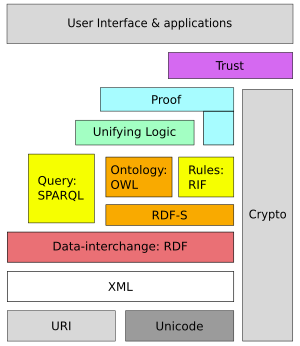 Tutorial01: Creating a simple RDF model
Tutorial01: Creating a simple RDF modelpackage tutorial;
import com.hp.hpl.jena.rdf.model.*;
import com.hp.hpl.jena.vocabulary.*;
public class Tutorial01 extends Object {
// some definitions
static String personURI = "http://somewhere/JohnSmith";
static String fullName = "John Smith";
public static void main (String args[]) {
// create an empty model
Model model = ModelFactory.createDefaultModel();
// create the resource
/*Resource johnSmith = model.createResource(personURI);
// add the property
johnSmith.addProperty(VCARD.FN, fullName);*/
//cascading ways
Resource johnSmith =
model.createResource(personURI)
.addProperty(VCARD.FN, fullName);
model.write(System.out,"Turtle");
}
}
 Tutorial02: vcard:N property takes a resource as its value. The ellipse representing the compound name has no URI. It is known as an blank Node.
Tutorial02: vcard:N property takes a resource as its value. The ellipse representing the compound name has no URI. It is known as an blank Node.package tutorial;
import com.hp.hpl.jena.rdf.model.Model;
import com.hp.hpl.jena.rdf.model.ModelFactory;
import com.hp.hpl.jena.rdf.model.Resource;
import com.hp.hpl.jena.vocabulary.VCARD;
public class Tutorial02 extends Object{
public static void main(String[] args) {
String personURI = "http://somewhere/JohnSmith";
String givenName = "John";
String familyName = "Smith";
String fullName = givenName + " " + familyName;
// create an empty Model
Model model = ModelFactory.createDefaultModel();
// create the resource
Resource johnSmith
= model.createResource(personURI)
.addProperty(VCARD.FN, fullName)
.addProperty(VCARD.N,
model.createResource() //for empty model
.addProperty(VCARD.Given, givenName)
.addProperty(VCARD.Family, familyName));
//model.write(System.out,"Turtle");
model.write(System.out);
//model.write(System.out,"RDF/XML-ABBREV");
//model.write(System.out,"N-TRIPLE");
}
}
Output: For model.write(System.out)
<rdf:RDF
xmlns:rdf="http://www.w3.org/1999/02/22-rdf-syntax-ns#"
xmlns:vcard="http://www.w3.org/2001/vcard-rdf/3.0#" >
<rdf:Description rdf:about="http://somewhere/JohnSmith">
<vcard:N rdf:nodeID="A0"/>
<vcard:FN>John Smith</vcard:FN>
</rdf:Description>
<rdf:Description rdf:nodeID="A0">
<vcard:Family>Smith</vcard:Family>
<vcard:Given>John</vcard:Given>
</rdf:Description>
</rdf:RDF>
Output: For model.write(System.out,"RDF/XML-ABBREV")
<rdf:RDF
xmlns:rdf="http://www.w3.org/1999/02/22-rdf-syntax-ns#"
xmlns:vcard="http://www.w3.org/2001/vcard-rdf/3.0#">
<rdf:Description rdf:about="http://somewhere/JohnSmith">
<vcard:N rdf:parseType="Resource">
<vcard:Family>Smith</vcard:Family>
<vcard:Given>John</vcard:Given>
</vcard:N>
<vcard:FN>John Smith</vcard:FN>
</rdf:Description>
</rdf:RDF>
Output: For model.write(System.out,"N-TRIPLE")
<http://somewhere/JohnSmith> <http://www.w3.org/2001/vcard-rdf/3.0#N> _:A492ebc41X3aX13480bf1cd8X3aXX2dX7fff .
<http://somewhere/JohnSmith> <http://www.w3.org/2001/vcard-rdf/3.0#FN> "John Smith" .
_:A492ebc41X3aX13480bf1cd8X3aXX2dX7fff <http://www.w3.org/2001/vcard-rdf/3.0#Family> "Smith".
_:A492ebc41X3aX13480bf1cd8X3aXX2dX7fff <http://www.w3.org/2001/vcard-rdf/3.0#Given> "John" .
Tutorial03: Print out the predicate, subject and object of each statement using StmtIterator
package tutorial;
import com.hp.hpl.jena.rdf.model.*;
import com.hp.hpl.jena.vocabulary.*;
// Tutorial 3 Statement attribute accessor methods
public class Tutorial03 extends Object {
public static void main (String args[]) {
// some definitions
String personURI = "http://somewhere/JohnSmith";
String givenName = "John";
String familyName = "Smith";
String fullName = givenName + " " + familyName;
// create an empty model
Model model = ModelFactory.createDefaultModel();
// create the resource
Resource johnSmith
= model.createResource(personURI)
.addProperty(VCARD.FN, fullName)
.addProperty(VCARD.N,
model.createResource()
.addProperty(VCARD.Given, givenName)
.addProperty(VCARD.Family, familyName));
// list the statements in the graph
StmtIterator iter = model.listStatements();
// print out the predicate, subject and object of each statement
while (iter.hasNext()) {
Statement stmt = iter.nextStatement(); // get next statement
Resource subject = stmt.getSubject(); // get the subject
Property predicate = stmt.getPredicate(); // get the predicate
RDFNode object = stmt.getObject(); // get the object
System.out.print(subject.toString());
System.out.print(" " + predicate.toString() + " ");
if (object instanceof Resource) {
System.out.print(object.toString());
} else {
// object is a literal
System.out.print(" \"" + object.toString() + "\"");
}
System.out.println(" .");
}
}
}
Output:
http://somewhere/JohnSmith http://www.w3.org/2001/vcard-rdf/3.0#N 5fbceadd:13480c6bb62:-7fff .
http://somewhere/JohnSmith http://www.w3.org/2001/vcard-rdf/3.0#FN "John Smith" .
5fbceadd:13480c6bb62:-7fff http://www.w3.org/2001/vcard-rdf/3.0#Family "Smith" .
5fbceadd:13480c6bb62:-7fff http://www.w3.org/2001/vcard-rdf/3.0#Given "John" .
Tutorial03: Print out the predicate, subject and object of each statement using StmtIterator
package tutorial;
import com.hp.hpl.jena.rdf.model.*;
import com.hp.hpl.jena.vocabulary.*;
// Tutorial 3 Statement attribute accessor methods
public class Tutorial03 extends Object {
public static void main (String args[]) {
// some definitions
String personURI = "http://somewhere/JohnSmith";
String givenName = "John";
String familyName = "Smith";
String fullName = givenName + " " + familyName;
// create an empty model
Model model = ModelFactory.createDefaultModel();
// create the resource
Resource johnSmith
= model.createResource(personURI)
.addProperty(VCARD.FN, fullName)
.addProperty(VCARD.N,
model.createResource()
.addProperty(VCARD.Given, givenName)
.addProperty(VCARD.Family, familyName));
// list the statements in the graph
StmtIterator iter = model.listStatements();
// print out the predicate, subject and object of each statement
while (iter.hasNext()) {
Statement stmt = iter.nextStatement(); // get next statement
Resource subject = stmt.getSubject(); // get the subject
Property predicate = stmt.getPredicate(); // get the predicate
RDFNode object = stmt.getObject(); // get the object
System.out.print(subject.toString());
System.out.print(" " + predicate.toString() + " ");
if (object instanceof Resource) {
System.out.print(object.toString());
} else {
// object is a literal
System.out.print(" \"" + object.toString() + "\"");
}
System.out.println(" .");
}
}
}
Output:
http://somewhere/JohnSmith http://www.w3.org/2001/vcard-rdf/3.0#N 5fbceadd:13480c6bb62:-7fff .
http://somewhere/JohnSmith http://www.w3.org/2001/vcard-rdf/3.0#FN "John Smith" .
5fbceadd:13480c6bb62:-7fff http://www.w3.org/2001/vcard-rdf/3.0#Family "Smith" .
5fbceadd:13480c6bb62:-7fff http://www.w3.org/2001/vcard-rdf/3.0#Given "John" .





